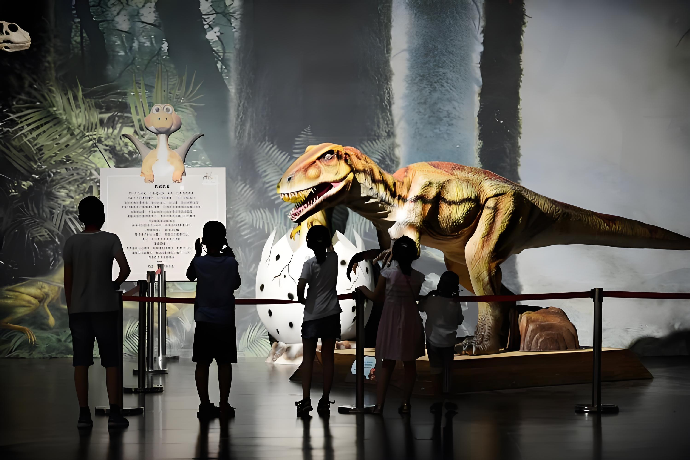Manufacturers of these
Animatronic Dinosaurs spare no effort in ensuring authenticity. They start with a solid steel frame, which serves as the backbone of the structure, providing stability and durability. This is then covered with a layer of high - density foam, carefully shaped to mimic the musculature of the prehistoric creatures. The outer skin is made from either silicone or latex, which not only looks incredibly realistic but also allows for a wide range of movement.
Advanced engineering techniques are employed to create fluid and natural - looking motions. Hydraulic and pneumatic systems are used to control the movement of the limbs, heads, tails, and jaws. For example, the head of a T - Rex can turn from side to side, its jaws can open wide to reveal sharp teeth, and its tail can swing menacingly, all in a synchronized manner. Some models are even designed to simulate breathing and heartbeat, adding to the overall lifelike experience.
Customization Options Galore
One of the most appealing aspects of these animatronic dinosaurs is the extensive customization available. Theme parks and museums can choose from a vast array of dinosaur species. From the iconic Tyrannosaurus rex, with its fearsome reputation, to the gentle - looking Diplodocus with its long neck, and the lesser - known but equally fascinating Ankylosaurus with its armored body, the options are nearly limitless.
Size is also a flexible parameter. Models can range from small, desktop - sized replicas that are perfect for interactive exhibits in museums to towering giants that can be the centerpiece of a theme park attraction. For instance, a life - size animatronic Brachiosaurus can stand several meters tall, creating an awe - inspiring sight for visitors.
In addition, the color and texture of the dinosaur's skin can be customized. Whether it's a realistic, earth - toned color scheme to match what scientists believe the dinosaurs looked like in the wild or a more fantastical, brightly - colored design for a themed event, the choice is up to the client. The skin can also be detailed with scales, bumps, and even feathers for species where evidence of feather - like structures has been discovered.
Applications in Theme Parks and Museums
In theme parks, these animatronic dinosaurs are a major draw. They can be used to create immersive prehistoric landscapes. For example, a Jurassic - themed area might feature a group of animatronic dinosaurs in a lush, artificial jungle setting. Some dinosaurs can be placed near water features, giving the impression that they are drinking or cooling off. Interactive elements can also be added, such as motion sensors that trigger the dinosaurs to move or make sounds when visitors approach, enhancing the engagement factor.
Museums, on the other hand, use these models to bring their exhibits to life. They can be part of educational displays, helping visitors better understand the anatomy and behavior of dinosaurs. For example, a museum might have an animatronic dinosaur model accompanied by detailed information panels about its diet, habitat, and evolutionary history. Some museums even use animatronic dinosaurs in their guided tours, with the docents using the moving models to illustrate key points about the prehistoric era.

The Impact on Visitor Experience
The introduction of custom lifelike animatronic dinosaur models has had a significant impact on the visitor experience. In theme parks, they have been shown to increase the length of time visitors spend in the park, as people are drawn to watch the dinosaurs and take pictures with them. This, in turn, can lead to increased revenue from food, beverage, and souvenir sales.
In museums, these models have been effective in making learning more engaging, especially for children. The moving and roaring dinosaurs capture the attention of young visitors, who are more likely to remember the information presented in the exhibits. This can help to foster an interest in science and history from an early age.
In conclusion, custom lifelike animatronic dinosaur models are revolutionizing the way theme parks and museums engage with their audiences. With their incredible craftsmanship, extensive customization options, and positive impact on visitor experience, they are set to remain a popular choice for years to come.







